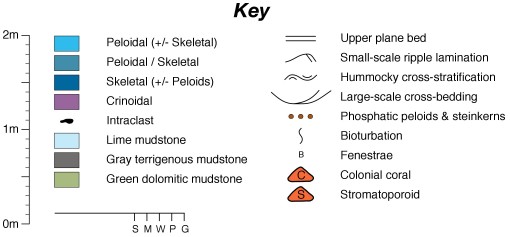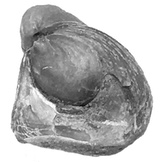Sequence Stratigraphy of the Nashville Ordovician: Meter-Scale Parasequences
A wide variety of parasequences, sedimentary cycles bounded by marine flooding surfaces, are present in the Ordovician rocks of the Nashville Dome. Most of these parasequences record upward shallowing, are up to a few meters thick (hence, meter-scale), and record tens of thousands of years of deposition. Four well-defined types of parasequences are recognized: peritdal parasequences that consist almost entire of pertidal facies, peritidal-capped parasequences that have a fully subtidal base with a thin peritidal cap, coarsening-upward parasequences that are subtidal and are typically capped by carbonate sands, and shallow subtidal parasequences that record an upward increase in the amount of bioturbation. The fifth type of parasequence is poorly defined and may be some other type of sedimentary cycle. A key to all of the sections is shown at the bottom.
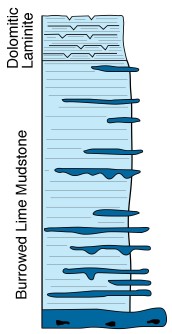
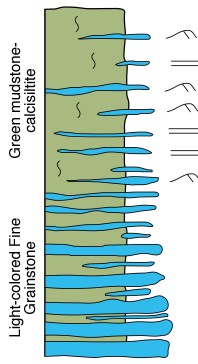
Peritidal parasequences
Peritidal parasequences consist almost entirely of peritidal facies, although they may have a shallow subtidal base. In the M1-M4 sequences, peritidal parasequences start with a thin intraclastic grainstone lag, are followed by burrowed lime mudstone facies, and are capped either by laminite or dolomitic laminite facies (left). Peritidal parasequences are uncommon in the M1-M4 sequences and never form thick successions. In the M6-C1 sequences of the southern Nashville Dome, peritidal parasequences consist of a basal light-colored grainstone facies and an upper green mudstone-calcisiltite facies (right). In the southern Nashville Dome of the M6-C1 sequences, these peritidal parasequences are common and can form thick successions.
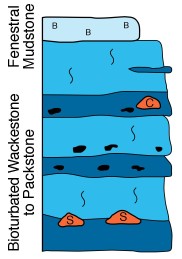
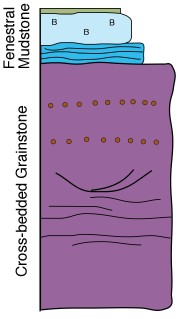
Peritidal-capped parasequences
Peritidal-capped parasequences are dominantly composed of a variety of subtidal facies, but have thin (usually less than 30 cm) caps of peritidal facies. In the M1-M4 sequences, peritidal-capped parasequences commonly consist of a basal bioturbated wackestone to packstone facies and an upper fenestral mudstone facies (left). In the M5-M6 sequences, peritidal-capped parasequences are commonly developed with a basal cross-bedded grainstone facies and an upper fenestral mudstone facies (right).
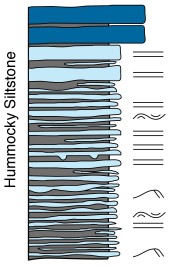
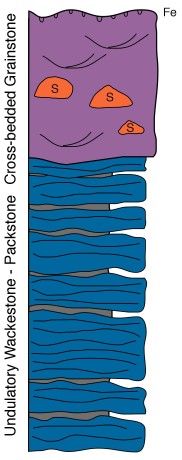
Coarsening-upward parasequences
Coarsening-upward parasequences are particularly common in the M5-C5 sequences. In the M5 sequence, these are commonly expressed as hummocky siltstone facies capped by one or more beds of skeletal grainstone, typically a brachiopod coquina (left). In the M5 through the C5, a variety of shallow subtidal facies, such as the undulatory wackestone-packstone facies, may be capped by a thick unit of cross-bedded grainstone facies (right).
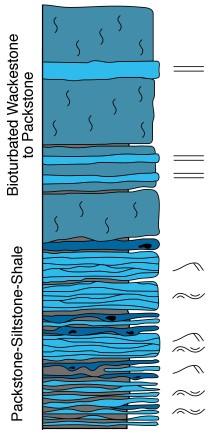
Shallow subtidal parasequences
Parasequences capped by shallow subtidal facies are common in the M1-M4 sequences. These typically consist of a basal packdstone-siltstone-shale facies and are overlain by bioturbated wackestone to packstone facies. A common characteristic of these parasequences is the upward thickening of beds as a result of progressively greater degrees of bioturbation.
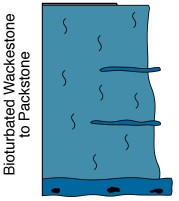
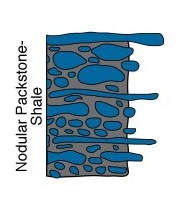
Poorly-defined parasequences
Throughout the Ordovician of the Nashville Dome are cyclic packages of strata bounded by surfaces across which there is little evidence of facies change. In the M1-M4 sequences, these cycles consist of bioturbated wackestone to packstone facies, often with a basal skeletal and intraclastic grainstone and capped by a thin (less than 10 cm) bed of dolomitic mudstone (left). This dolomitic mudstone may be peritidal in origin, but it lacks clear evidence of subaerial exposure. In the M6-C4 sequences, similar cycles are developed where nodular packstone-shale facies ar capped by laterally persistent beds of skeletal grainstone (right).
